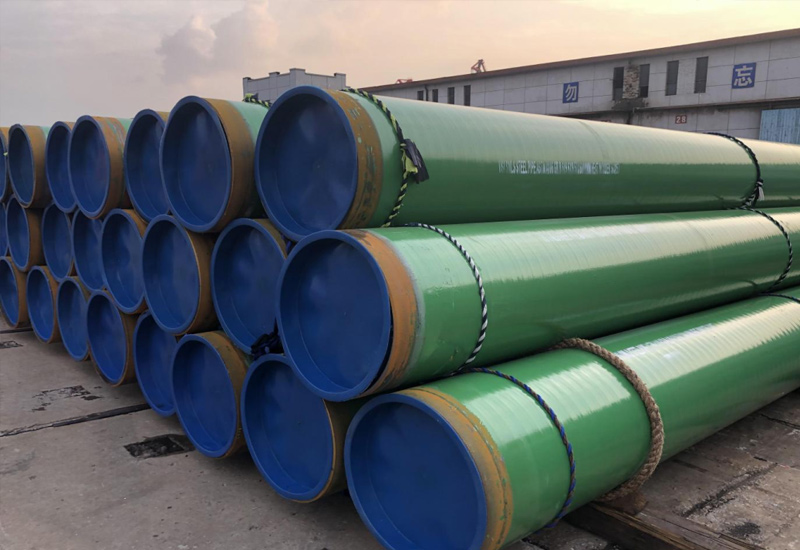HOT BLOG TAGS
SY/T 5037
SY/T 5037-2023 Technical Standard: Submerged Arc Welded Steel Pipes for General Fluid Transportation
1. Standard Overview and Background
SY/T 5037, an industry standard developed by National Energy Administrationof China, is applicable to submerged arc welded steel pipe for general fluid transmission. The present standard new 2023 edition (SY/T 5037-2023) was issued in October 2023 and put into practice in April 2024, replacing the 2018 edition. It is managet by the Petroleum Tubular Goods Standardization Committee and written by Baoji Petroleum Steel Pipe Co.,Ltd, and so on.
Basic Description: This standard specifies the type of LSAW or SSAW, dimensions, materials, test requirements, test methods, and inspection countersunk socket joint, identificaion, packing etc. While meeting demands for agricultural irrigation and municipal water systems, it also provides a safe and reliable solution for water, air, steam and other non-corrosive fluids.
2. Scope of Application
2.1 Primary Applications
Fluid Types: Water, air, heating steam, and non-corrosive fluids;
Engineering Scenarios:
Municipal water supply/drainage, long-distance water transfer (e.g., South-North Water Diversion Project)
Agricultural irrigation, coal/mineral slurry pipelines
Low-pressure gas distribution and industrial cooling systems;
Structural Use: Supports socket-spigot flexible joints with rubber seals for rapid assembly and seismic adaptability.
2.2 Key Performance Adaptations
Pressure Range: Design pressure ≤4.0 MPa (medium-low pressure systems);
Environmental Suitability:
Ambient to medium temperatures (≤120°C);
Requires external coatings (e.g., coal-tar epoxy) for buried corrosion resistance.
3. Dimensions and Tolerances
3.1 Size Ranges
Outside Diameter (OD): 273–2540 mm (large diameters >1422 mm for main water lines);
Wall Thickness (WT): 5–25 mm (enhanced design up to 60 mm for X70 grade);
Length (L): 6–12 m (±500 mm tolerance; precise lengths require agreement).
3.2 Tolerance Requirements
*Table 1: Key Tolerances (SY/T 5037-2023)*
| Parameter | Size Range | Permissible Deviation |
| Pipe Body OD | <508 mm | ±0.75% OD (Max ±2.5 mm) |
| ≥508 mm | ±1.00% OD (Max ±4.5 mm) | |
| Pipe End OD | 100 mm from end | Max OD ≤1.01D, Min OD ≥0.99D |
| Wall Thickness | <508 mm | ±12.5% WT |
| ≥508 mm | ±10.0% WT | |
| End Squareness | <813 mm | ≤1.6 mm |
| ≥813 mm | ≤3.0 mm |
Geometric Tolerances:
Ovality: OD variation ≤1% at pipe ends (100 mm range);
Straightness: Overall bow ≤0.2% L; local deviation (1 m) ≤2 mm;
End Bevel: Angle 30°±5°, root face 1.6±0.8 mm.
4. Testing and Inspection
4.1 Mandatory Tests
Hydrostatic Test:
Pressure Formula: P = 2St/D (S = 60% yield strength; min. 1.0 MPa);
Duration: ≥5 s (≥10 s for OD >813 mm);
Alternative: UT + RT for DN<600 mm pipes.
Non-Destructive Examination (NDE):
Weld Inspection: 100% UT + RT; RT acceptance per GB/T 3323 Level II;
Defect Sensitivity: UT detects ≥50×1×12.5% WT reference notches.
4.2 Material Performance Tests
Mechanical Tests:
Tensile Test: 2 samples/batch (≤100 pipes); measures yield (RₑL), tensile strength (Rₘ), elongation;
Charpy Impact: Optional per agreement; ≥40 J avg. at 0°C for Q355B;
Guided Bend Test: Evaluates weld toughness; mandrel ≤4×WT (2023 adds reverse bend).
5. Chemical Composition and Mechanical Properties
5.1 Grades and Chemistry
Covers carbon and low-alloy steels:
Q235B (Carbon steel): Low-pressure water pipes;
Q355B (Low-alloy steel): High-strength applications;
20# Steel (New in 2023): Improved weldability/toughness.
Table 2: Chemical Requirements (wt%, PSL 1)
| Element | Q235B | Q355B | 20# Steel |
| C ≤ | 0.20 | 0.20 | 0.20 |
| S ≤ | 0.035 | 0.035 | 0.030 |
| P ≤ | 0.035 | 0.035 | 0.030 |
| Mn ≤ | 1.40 | 1.60 | 0.70 |
Impurity Control: Strict S/P limits mitigate hot/cold brittleness.
5.2 Mechanical Properties
Table 3: Mechanical Requirements
| Grade | Yield Strength (MPa) | Tensile Strength (MPa) | Elongation (%) |
| Q235B | ≥235 | 370–500 | ≥25 |
| Q355B | ≥355 | 470–630 | ≥22 |
| 20# Steel | ≥245 | ≥410 | ≥24 |
Yield-to-Tensile Ratio: ≤0.93 (prevents overload fracture);
Weld Strength: ≥95% of base metal.
6. Key Updates in 2023 Edition
Major revisions vs. 2018:
Dimensions & Tolerances:
Extended OD to 2540 mm; refined tolerances for >1422 mm pipes;
Standardized circumference calculation (π=3.14).
Material & Testing:
Added 20# steel grade;
Enhanced Charpy impact criteria with low-temp toughness;
Introduced reverse-bend test for weld assessment.
Defect Control:
Repair limits: Single repair ≤150 mm; total ≤300 mm/pipe;
Reduced misalignment: ≤0.15t for WT≤12.5 mm (was 0.2t).
7. Engineering Applications & Future Trends
SY/T 5037-2023 ensures safety through full-process quality control:
Manufacturing Protocols:
SSAW pipes use double-sided SAW; strip joints ≥300 mm from pipe ends;
Socket joints: Integral forming (expansion/rolling) or welded.
Defect Management:
Scratches: Grind if depth <3 mm; weld repair if deeper;
Laminations: Cut out if >6.4 mm.
Future Developments:
Sustainability: Low-carbon steelmaking (e.g., hydrogen metallurgy) for hydrogen transport;
Digitalization: Automated UT (ISO 10893-11) and digital RT (GB/T 40385);
Standard Integration: Alignment with GB/T 9711 (oil/gas pipes) and GB/T 13295 (ductile iron pipes).
Conclusion: Balancing Safety and Efficiency
SY/T 5037-2023 provides a robust technical framework for general fluid pipelines via precise tolerances, material grading, and rigorous testing. Continuous updates (e.g., 20# steel, joint optimization) reflect responsiveness to engineering demands. As materials and NDE technologies evolve, this standard will further harmonize safety and resource efficiency.










